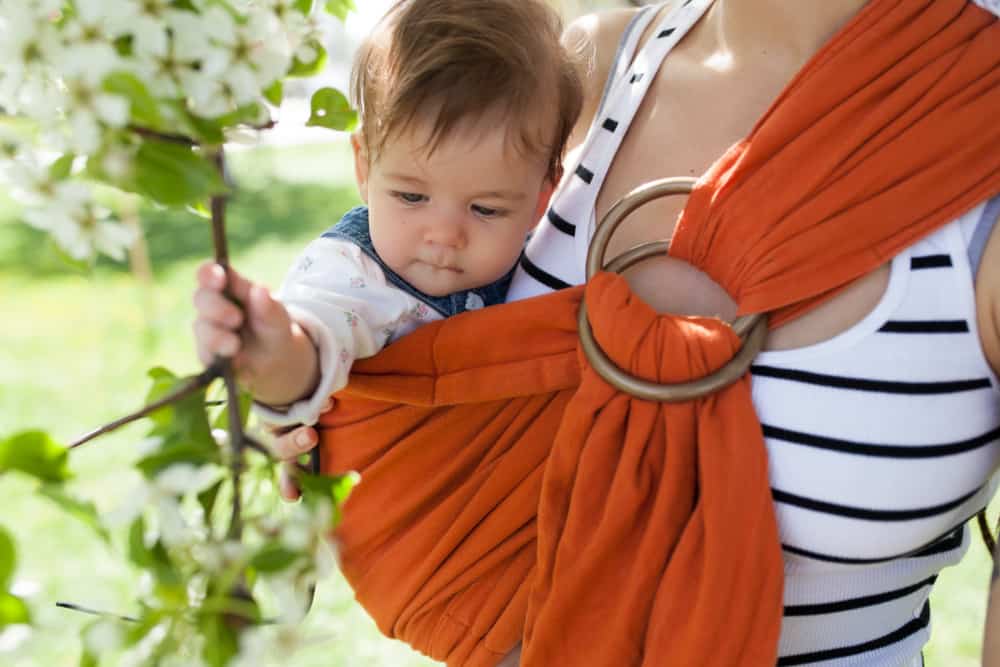How to Use a Sling With an Older Baby
Does the thought of figuring out how to use a baby sling have you all tied up in knots? Baby slings are a fun and practical way to wear your baby, but many moms find them daunting because it can take a bit of time to master the techniques.
The first time I used a ring sling, it was a disaster. I couldn't seem to position my infant correctly and I was terrified I would hurt her. Thankfully I had a friend who was willing to show me the proper technique — she was my support system, and now it's time that I pay it forward.
In this article, we are going to dive into everything ring sling related. We'll talk about why you should choose a ring sling, and why you might prefer other options instead. We'll go over safety considerations, common questions and tips, and we will give you step-by-step instructions on how to do several types of carries.
- The Rundown on Ring Slings
- Safety Considerations To Keep in Mind
- How Do I Prepare My Sling?
- Basic Techniques for Handling Your Sling
- Your Guide to Mastering Sling Positions
- Breastfeeding in a Ring Sling
- Troubleshooting Your Ring Sling
- Ring Sling FAQs
The Rundown on Ring Slings
First things first, what exactly is a ring sling? A ring sling is a long strip of fabric, available in a wide variety of patterns and colors, that is secured at your shoulder with a set of rings. This makes a sling that securely allows you to carry your baby while taking pressure off your arms and back (1).
A ring sling's advantages go far beyond its fabric option. It allows you to have skin-to-skin contact with your baby while allowing you to communicate with your little one.
It's also a hands-free carry option. You don't have to use a stroller, which gives you access to the stairs when you're out instead of having to search for a ramp or elevator.
That doesn't mean a ring sling is without its disadvantages though. In hot weather, they can become uncomfortable for both you and your baby, and if you have a lot to carry, it can become an impractical option.
Weigh Your Options
As with anything you use to carry your baby, you must take these pros and cons into consideration before deciding whether a ring sling is right for you.
Safety Considerations To Keep in Mind
No matter how you decide to transport your baby, safety should be your top priority. To make sure your baby is safe while being worn in a ring sling, there are a few things you will want to do.
Before you ever place your baby into a ring sling, you must ensure the swing is safe. When you purchase your sling, take your child with you, ask for a demonstration on how it should be used, and avoid slings that are marketed with terms such as 'womb-like' and 'cocoon.' These could hold your baby in an unsafe manner.
Each time you put your baby in the sling, check it to make sure it's in good condition. You need to make sure it doesn't have any tears or snags that might compromise its ability to hold your baby.
The Position Matters
When you put your baby in the swing, you want to make sure their airway is open. You also want their legs and hips positioned safely and make sure their back and neck are supported.
Your baby should be held high and snug next to your chest. If your baby is small, has a cold, or is born premature, ask your doctor before wearing them in the sling.
Lastly, use caution and your instincts when it comes to wearing your baby. Be careful when holding hot drinks over your baby, carrying something heavy, and check often to make sure your baby is safe and secure in the sling.
How Do I Prepare My Sling?
My aunt once told me that any good recipe requires a little bit of preparation first. I think the same goes for most things in life, including your ring sling. While you might be tempted to put your baby in your ring sling as soon as you get it out of the box, there are a few things you should do first.
Ensure You Have the Right Size
Every parent doesn't wear the same shirt size, and not every parent wears the same sling size. Be sure you have the right size for a sling so it will hold your baby snugly, safely, and securely.
Each brand of ring sling will differ in size slightly. For example, a small/medium Tula ring sling is roughly 77 inches in length. On the other hand, a small Bijou sling is 70 inches, while a medium is 75 inches.
How To Know
In general, you can usually go by your t-shirt size when choosing a ring sling. You might want to go up a size, though, if you have a large bust, a wide ribcage, or are wearing a toddler.
Threading a Ring Sling
Threading is the process of weaving the fabric through the rings to secure the wrap to carry your baby. To thread your sling, simply:
- Start by deciding which side of your body you want to hold your baby on. If you're going to hold your baby on your right side, you will put the rings onto your left shoulder.
- Hold your sling by the rings, then bring it behind you and drape it over your shoulder.
- Bring the tail around your back and gather it up at your front.
- Take the entire tail, place it under and through both rings.
- Allow the tail to go forward, so the top hem is falling toward your midline; the bottom hem will be toward the outside of your body.
- Open both rings, and work the fabric through the bottom ring slowly.
- Check that your tail's top hem is still toward your midline, and the bottom hem is at the outside of your body.
- Place both of your thumbs into the part of your tail woven between the rings, then pull it out to loosen it a bit.
- Starting with your top hem, gently gather this piece strand by strand. If you have a striped sling, you will see you can fan out and gather it stripe by stripe easily.
- Lastly, grab your top and bottom hem of your tail and pull them out to tighten the sling. Repeat this with the inner sections of the sling to make sure the entire sling is snug.
Basic Techniques for Handling Your Sling
There are several different holds and carries you can use with your ring sling. But before we jump into the more complicated aspects of babywearing in a ring sling, let's go over some basics.
Putting Your Sling on Properly
Putting your sling on correctly will ensure it is safe and secure to hold your baby. To properly put on your sling:
- Start by threading your sling. You can do this by first putting the sling over your shoulder and then threading it. Or by threading it in your hands first and then placing it over your shoulder.
- Put the rings as high as possible on your shoulder, especially when you are first starting. This is because the rings do move down a little as you adjust the sling.
- Preset the position of the sling before putting your baby in. You want the bottom hem to be even with your belly button. You can do this by holding the pouch out slightly as you tighten the sling, allowing you to adjust it slowly until you get it to the place it needs to be.
- Once you are done, you can place your baby in the sling.
Positioning the Ring
The metal rings on your sling can cause some discomfort if they are not positioned properly. I once bruised my collarbone because the rings sat on them for too long under my baby's weight. I don't recommend it.
Instead, you want your rings to be positioned just below your shoulder for the most comfort and support.
Tightening Your Sling
You might find your sling is too loose, causing your baby to be sitting too low in the sling. Luckily, tightening your sling is a fairly easy process, and your baby can stay in the sling the entire time. To tighten the sling:
- While holding your baby with one hand, pull up on the ring that the tail of your fabric is going under. This will cause your sling to loosen even further.
- Lift your baby to where you want them to be, and pull the top hem across your body until it is as snug as you desire.
- Repeat with the bottom hem, and again with the middle section of your wrap to keep the entire wrap snug and secure.
Newborns Vs. Toddlers
Ring slings can be used for both newborns and toddlers, so they are a great option for moms who only want to buy one carrier for their baby. Both newborns and toddlers should be held in an upright position with their back, shoulders, and hips supported sufficiently.
Positioning Your Baby in the Seat
You want your baby to be sitting wide in their seat, with a third of the fabric tucked up under them. Their legs should be positioned so their knees are above their hip sockets. This positioning helps to prevent future hip conditions.
Your Guide to Mastering Sling Positions
As with a wrap, a ring sling is versatile. You can wear your baby on your chest, your hip, and even on your back. Here are some step-by-step instructions for several different carries.
Breastfeeding in a Ring Sling
You can feed your baby in your ring sling. It will just take a little bit of work.
First off, don't plan on it being a hands-free breastfeeding experience. No breastfeeding session is hands-free. Sorry, mama!
But you don't have to take your baby all the way out to feed them, so that's a positive.
When breastfeeding your baby in your ring sling, loosen the panel in stages so your baby is gently lowered down to your nipple. Feed them in this position.
Then when they are done, return your baby to the snug and upright position they were in initially. This way they stay safe as you continue to wear them.
Troubleshooting Your Ring Sling
You've started to use your sling, but you find you're struggling in a few areas. Mama, you are not alone. Everyone has questions, and we are happy to help you out.
Below are some tips to help you find success with your ring sling.
Ring Sling FAQs
Are there things about your ring sling that still have you scratching your head in confusion? Don't worry, we have you covered with answers to your common ring sling questions.
How to Use a Sling With an Older Baby
Source: https://momlovesbest.com/using-baby-slings
0 Response to "How to Use a Sling With an Older Baby"
Post a Comment